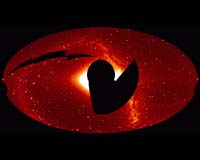 |
Washington DC (SPX) Nov 28, 2010 Astronomers have found the first evidence of a magnetic field in a jet of material ejected from a young star, a discovery that points toward future breakthroughs in understanding the nature of all types of cosmic jets and of the role of magnetic fields in star formation. Throughout the Universe, jets of subatomic particles are ejected by three phenomena: the supermassive black holes at the cores of galaxies, smaller black holes or neutron stars consuming material from companion stars, and young stars still in the process of gathering mass from their surroundings. Previously, magnetic fields were detected in the jets of the first two, but until now, magnetic fields had not been confirmed in the jets from young stars. "Our discovery gives a strong hint that all three types of jets originate through a common process," said Carlos Carrasco-Gonzalez, of the Astrophysical Institute of Andalucia Spanish National Research Council (IAA-CSIC) and the National Autonomous University of Mexico (UNAM). The astronomers used the National Science Foundation's Very Large Array (VLA) radio telescope to study a young star some 5,500 light-years from Earth, called IRAS 18162-2048. This star, possibly as massive as 10 Suns, is ejecting a jet 17 light-years long. Observing this object for 12 hours with the VLA, the scientists found that radio waves from the jet have a characteristic indicating they arose when fast-moving electrons interacted with magnetic fields. This characteristic, called polarization, gives a preferential alignment to the electric and magnetic fields of the radio waves. "We see for the first time that a jet from a young star shares this common characteristic with the other types of cosmic jets," said Luis Rodriguez, of UNAM. The discovery, the astronomers say, may allow them to gain an improved understanding of the physics of the jets as well as of the role magnetic fields play in forming new stars. The jets from young stars, unlike the other types, emit radiation that provides information on the temperatures, speeds, and densities within the jets. This information, combined with the data on magnetic fields, can improve scientists' understanding of how such jets work. "In the future, combining several types of observations could give us an overall picture of how magnetic fields affect the young star and all its surroundings. This would be a big advance in understanding the process of star formation," Rodriguez said. Carrasco-Gonzalez and Rodriguez worked with Guillem Anglada and Mayra Osorio of the Astrophysical Institute of Andalucia, Josep Marti of the University of Jaen in Spain, and Jose Torrelles of the University of Barcelona. The scientists reported their findings in the November 26 edition of Science.
Share This Article With Planet Earth
Related Links NRAO Stellar Chemistry, The Universe And All Within It
 Exploding Stars - What Are We Missing
Exploding Stars - What Are We MissingLiverpool, UK (SPX) Nov 25, 2010 A PhD student studying at Liverpool John Moores University's (LJMU) Astrophysics Research Institute has opened a new chapter in observations and understanding of the nova class of exploding star. This collaborative research with two San Diego universities has shown that even the brightest stellar explosions are being missed. The work of student Rebekah Hounsell is actually a by-product of ... read more |
|
| The content herein, unless otherwise known to be public domain, are Copyright 1995-2010 - SpaceDaily. AFP and UPI Wire Stories are copyright Agence France-Presse and United Press International. ESA Portal Reports are copyright European Space Agency. All NASA sourced material is public domain. Additional copyrights may apply in whole or part to other bona fide parties. Advertising does not imply endorsement,agreement or approval of any opinions, statements or information provided by SpaceDaily on any Web page published or hosted by SpaceDaily. Privacy Statement |